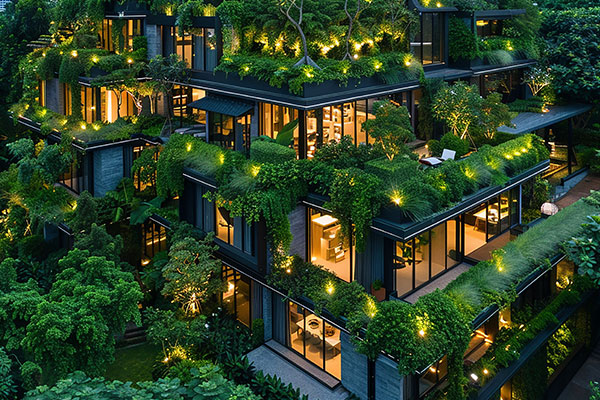The Shift Towards Green Building Practices in Property Development

As environmental concerns and sustainability become increasingly pivotal in the property development sector, green building practices are gaining traction. This shift is driven by a growing awareness of climate change, resource depletion, and the need for energy efficiency. Green building practices aim to reduce the environmental impact of construction projects while enhancing the quality of living spaces. This blog explores the rise of green building practices in property development and their implications for the real estate market.
Key Aspects of Green Building Practices
Energy Efficiency and Resource Conservation
- Energy-Efficient Designs: Modern green buildings incorporate energy-efficient designs such as better insulation, high-performance windows, and energy-efficient HVAC systems. These measures reduce the amount of energy required for heating, cooling, and lighting.
- Impact: According to the U.S. Green Building Council, green buildings can reduce energy consumption by up to 30% compared to traditional buildings. This not only lowers utility costs for occupants but also reduces the building's carbon footprint.
Sustainable Materials and Construction Methods
- Material Choices: Green buildings use sustainable materials like recycled steel, bamboo, and low-impact concrete. These materials are chosen for their reduced environmental impact and sustainability.
- Construction Practices: Construction methods are also adapted to minimize waste and environmental disruption. Techniques such as modular construction and the use of prefabricated components help reduce construction waste and time.
- Impact: The use of sustainable materials and methods can reduce a building's overall environmental impact by up to 50%, according to the World Green Building Council.
Water Efficiency and Management
- Water-Saving Features: Green buildings often incorporate water-saving features such as low-flow fixtures, rainwater harvesting systems, and greywater recycling.
- Impact: These measures help reduce water consumption and manage stormwater runoff, contributing to better resource management and environmental sustainability.
Indoor Environmental Quality
- Healthy Interiors: Green buildings focus on enhancing indoor air quality by using low-VOC (volatile organic compounds) paints, improved ventilation systems, and natural lighting.
- Impact: Improved indoor environmental quality can lead to better health and well-being for occupants, with studies indicating increased productivity and reduced absenteeism in green buildings.
Implications for the Real Estate Market
Increased Demand for Green Buildings
- Market Trends: As awareness of environmental issues grows, there is a rising demand for green buildings from both residential and commercial buyers. Many buyers are willing to pay a premium for properties that offer energy savings and environmental benefits.
- Impact: This shift is driving property developers to adopt green building practices to meet market expectations and attract environmentally conscious buyers.
Regulatory and Financial Incentives
- Government Policies: Governments are increasingly implementing policies and incentives to encourage green building practices. These can include tax benefits, grants, and certifications for buildings that meet specific environmental standards.
- Impact: Such incentives make it more financially viable for developers to invest in green building practices and can enhance the long-term value of properties.
Challenges and Considerations
- Cost Considerations: While green building practices offer long-term savings, the initial costs of implementing these practices can be higher than traditional methods. Developers must weigh these costs against potential long-term benefits.
- Market Education: Educating stakeholders, including developers, investors, and buyers, about the benefits and value of green buildings is crucial for the continued growth of this market segment.
Conclusion
The shift towards green building practices represents a significant transformation in property development, driven by the need for environmental sustainability and energy efficiency. While there are challenges to adopting these practices, the long-term benefits of reduced energy consumption, resource conservation, and improved indoor quality make green building an increasingly attractive option for developers and buyers alike. As the real estate market continues to evolve, green building practices will likely play a central role in shaping the future of property development.
-
xSpK Reply (2025-08-19 16:19:47) VoUk
-
xSpK Reply (2025-08-19 16:19:47) VoUk
-
xSpK Reply (2025-08-19 16:19:48) VoUk
-
xSpK Reply (2025-08-19 16:19:48) VoUk
-
xSpK Reply (2025-08-19 16:19:49) VoUk
-
xSpK Reply (2025-08-19 16:19:56) VoUk
-
xSpK Reply (2025-08-19 16:19:57) VoUk
-
xSpK Reply (2025-08-19 16:19:57) VoUk
-
xSpK Reply (2025-08-19 16:19:58) VoUk
-
xSpK Reply (2025-08-19 16:19:59) VoUk
-
xSpK Reply (2025-08-19 16:19:59) VoUk
-
xSpK Reply (2025-08-19 16:20:00) VoUk
-
xSpK Reply (2025-08-19 16:20:00) VoUk
-
xSpK Reply (2025-08-19 16:20:01) VoUk
-
xSpK Reply (2025-08-19 16:20:01) VoUk
-
xSpK Reply (2025-08-19 16:20:02) VoUk
-
xSpK Reply (2025-08-19 16:20:03) VoUk
-
xSpK Reply (2025-08-19 16:20:03) VoUk
-
xSpK Reply (2025-08-19 16:20:04) VoUk
-
xSpK Reply (2025-08-19 16:20:04) VoUk
-
xSpK Reply (2025-08-19 16:20:05) VoUk
-
xSpK Reply (2025-08-19 16:20:06) VoUk
-
xSpK Reply (2025-08-19 16:20:06) VoUk
-
xSpK Reply (2025-08-19 16:20:07) VoUk
-
xSpK Reply (2025-08-19 16:20:07) VoUk
-
xSpK Reply (2025-08-19 16:20:08) VoUk
-
xSpK Reply (2025-08-19 16:20:09) VoUk
-
xSpK Reply (2025-08-19 16:20:09) VoUk
-
xSpK Reply (2025-08-19 16:20:10) VoUk
-
xSpK Reply (2025-08-19 16:20:10) VoUk
-
xSpK Reply (2025-08-19 16:20:11) VoUk
-
xSpK Reply (2025-08-19 16:20:11) VoUk
-
xSpK Reply (2025-08-19 16:20:12) VoUk
-
xSpK Reply (2025-08-19 16:20:12) VoUk
-
xSpK Reply (2025-08-19 16:20:13) VoUk
-
xSpK Reply (2025-08-19 16:20:13) VoUk
-
xSpK Reply (2025-08-19 16:20:14) VoUk
-
xSpK Reply (2025-08-19 16:20:15) VoUk
-
xSpK Reply (2025-08-19 16:20:15) VoUk
-
xSpK Reply (2025-08-19 16:20:16) VoUk
-
xSpK Reply (2025-08-19 16:20:16) VoUk
-
xSpK Reply (2025-08-19 16:20:17) VoUk
-
xSpK Reply (2025-08-19 16:20:17) VoUk
-
xSpK Reply (2025-08-19 16:20:18) VoUk
-
xSpK Reply (2025-08-19 16:20:18) VoUk

Write Comments